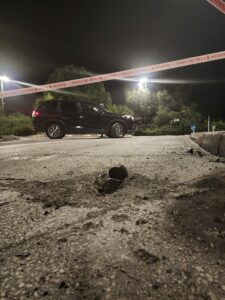Hezbollah’s use of the Burkan rocket with its massive warhead in recent attacks on Northern Israel signifies a significant escalation in the type of weaponry Hezbollah employs and serves as a reminder of Hezbollah’s ability to substantially threaten both military and civilian targets in Israel.
As long as Hezbollah can threaten civilian communities near the northern border of Israel with such firepower and with warheads of this magnitude, there is real doubt about the ability of northern civilians from this area to return to their homes. Only the interception of this short-range yet especially lethal capability, along with distancing Reduan force activists from the border, will allow for the return of the residents of Northern Israel to their homes near the Lebanese border.
On November 4, Hezbollah fired Burkan rockets at a military base in the north of the country. On November 20, Hezbollah took responsibility for firing Burkan rockets at an IDF base in Biranit in the north. The attack did not cause casualties, but it did cause significant damage at the rocket impact site.


The Burkan is a rocket with a range of up to 10 km, notable for its very heavy explosive head, which can range from 100 kg to 500 kg of explosives. The rocket can cause extensive destruction within a radius of 150 meters from the impact point.
The Syrian CERS Institute specialized in the production of such rockets during the Syrian Civil War. Burkan rockets were used by Assad’s army and his allies from the Iranian Shiite axis during the civil war and were part of the siege warfare tactics against the rebel forces and the civilian population, especially in urban areas, where they caused massive destruction. It should be noted that the aerial version of the Burkan comes in the form of explosive barrels dropped from helicopters on settlements.

The Burkan rocket is launched from small trucks or ground launchers. According to a report by Al-Nahar, as of 2016, Hezbollah has hundreds of Burkan rockets, with each rocket costing between $300 and $400. A cheap weapon with great effectiveness.
We estimate that today Hezbollah has a larger arsenal of this type of rockets, possibly thousands, and it is highly likely that Hezbollah has the capability of self-production.
Hezbollah can operate the Burkan rocket in two scenarios: the first, firing at settlements. The second, as it does today, firing at Israeli military bases (or military force concentrations), attempting to hit targets located near the Lebanese border. If a full-scale war breaks out, the Burkan rocket can be used by Hezbollah to fire at IDF forces maneuvering in Lebanese territory, with an emphasis on maneuvers in built-up areas.
It should be noted that in the Gaza Strip, according to assessments on the eve of the October 7 attack, Hamas and Palestinian Islamic Jihad also have Burkan rockets in their arsenal.
The appearance of the Burkan on the northern border marks a new stage in the development of Hezbollah’s threat. To this, we add the challenge of intercepting these rockets mainly due to their short range and relatively low altitude as they move toward the target.
According to a November 22 publication by Dr. Yehoshua Kalisky, a senior researcher at the Institute for National Security Studies, “It is important to note that the short range of the rocket is a challenge for kinetic interception, for instance, by means of Iron Dome. Besides the offensive option, namely destroying the launch trucks of the Burkan, another plausible option for intercepting the rocket is by using a laser cannon, which fires a high-power light beam at the target in fractions of seconds, ‘cooking’ critical parts of the rocket during its flight, and causing a structural failure and its fall far from the target it was sent to.”







